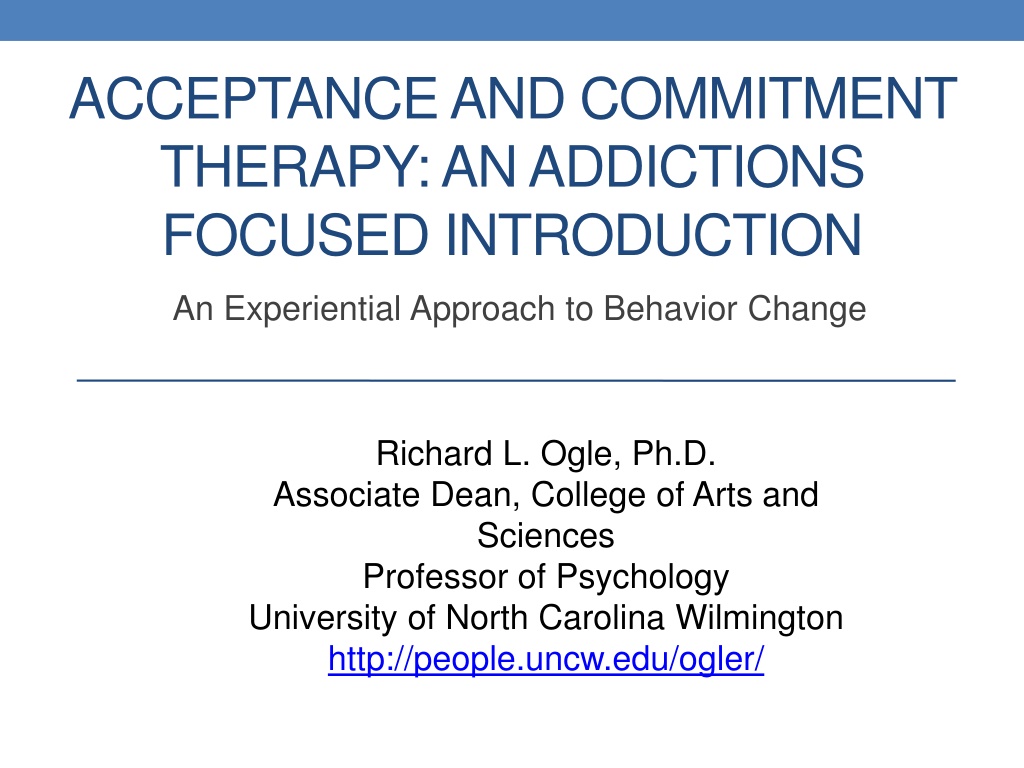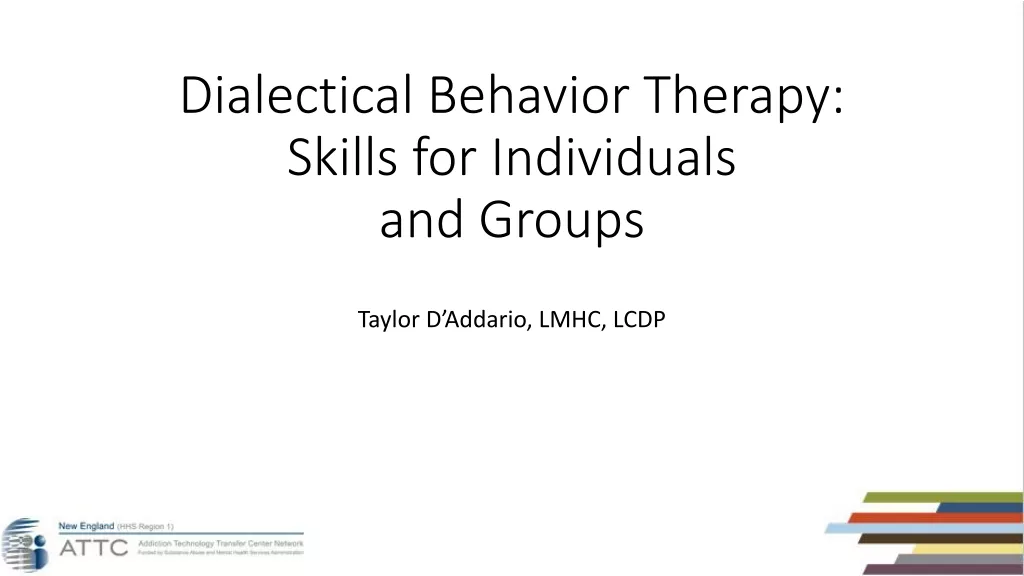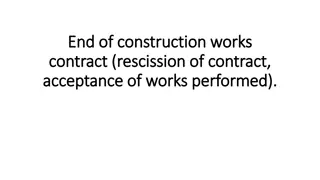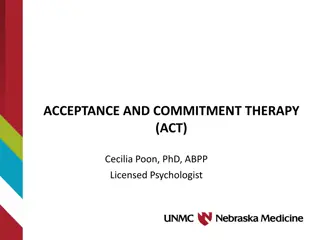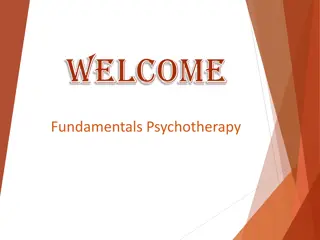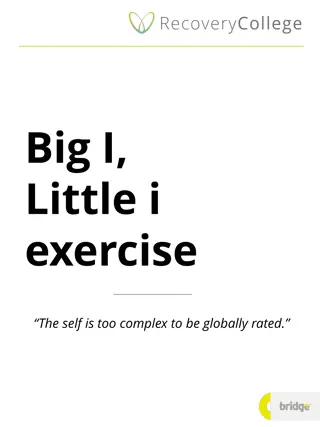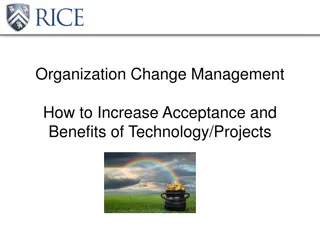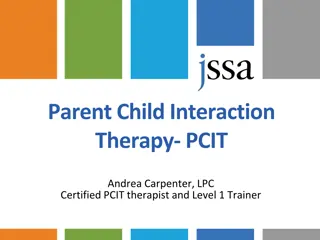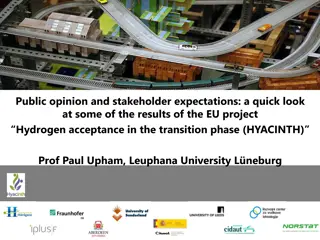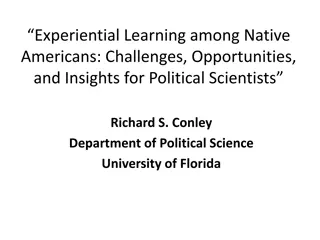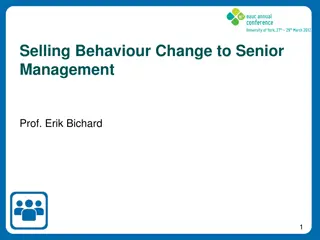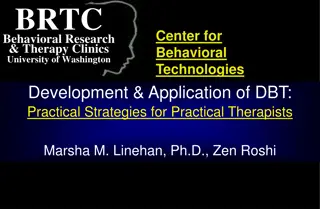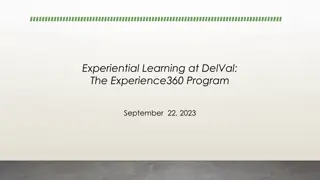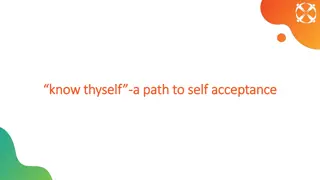Experiential Approach to Behavior Change in Acceptance and Commitment Therapy
Delve into Acceptance and Commitment Therapy (ACT) with an addiction-focused introduction by Richard L. Ogle, Ph.D. Explore ACT assumptions, the philosophy of workable relationships, basic science in Relational Frame Theory (RFT), and the impact of language on behavior and cognition.
Download Presentation

Please find below an Image/Link to download the presentation.
The content on the website is provided AS IS for your information and personal use only. It may not be sold, licensed, or shared on other websites without obtaining consent from the author. Download presentation by click this link. If you encounter any issues during the download, it is possible that the publisher has removed the file from their server.
E N D
Presentation Transcript
ACCEPTANCE AND COMMITMENT THERAPY: AN ADDICTIONS FOCUSED INTRODUCTION An Experiential Approach to Behavior Change Richard L. Ogle, Ph.D. Associate Dean, College of Arts and Sciences Professor of Psychology University of North Carolina Wilmington http://people.uncw.edu/ogler/
Welcome, I Am Grateful You Are Here Having spent the better part of my life trying to either relive the past or experiencing the future before it arrives, I have come to believe that in between these two extremes is peace.
ACT Assumptions - Philosophy Emphasis on pragmatic view of truth/right. Functionally workable relationships. What works for one might not work for another In the case of humans, there are three contextual fields: Covert behavior (thoughts, feelings, memories, sensations), Overt behavior Controlling environmental influences All contextual fields must be taken into account if you are going to establish workability
ACT Assumptions Basic Science (RFT) Eliminating verbal relations is impossible because they are historically acquired and automatically conditioned All forms of human experience, both real and imagined, can enter into these relations and govern behavior - rules Rule governed relations are insensitive to direct environmental contingencies All verbal relations function behind the eyes and therefore operate directly in the moment they exert behavioral control It is possible to exert control over the FUNCTIONS but not the FORM of verbal relations A behavioral account of language and cognition Language is based on arbitrary learned relations between stimuli Provides an evolutionary advantage, but also expands our ability to feel, predict, categorize & evaluate Makes behavioral avoidance possible and cognitive dominance likely Experiential avoidance and cognitive fusion are built into language and amplified by the culture; they are implicated in psychopathology.
ACT Assumptions - The Bottom Line The root of suffering language We can t live without it, but we can t live with it Unwanted internal experiences simply cannot be avoided The two central culprits from an ACT point of view are. . . Cognitive Fusion: Mistaking private events as reality Experiential Avoidance: Unwillingness to make contact with undesirable, unwanted private mental events, leading to ever widening patterns of behavioral constriction
The Principle of Destructive Normalcy Health is defined as the absence of distressing private content When you have distressing private content, that is a sign you are not healthy and abnormal The goal therefore is to eliminate the distressing content in the service of being normal (the culture of feel goodism ) In the event distressing content cannot be readily controlled or eliminated, the human is required to come up with a justification for why that is so (reasons) Reasons are culturally taught to be good causes The goal therefore is to eliminate and/or control the identified reasons in the service of achieving health
The ACT Model of Human Suffering and Psychopathology Human pain (physical and psychological) is ubiquitous, normal, and self-restorative Unwillingness to have pain leads to reliance on avoidance and control based strategies Excessive use of control & avoidance leads to a loss of contact with committed actions & vital purposeful living It is not physical/mental pain per se that is the enemy but our attempts to avoid or control it lead to disorder and suffering This cycle of suffering is strongly supported in the culture through language acquisition and socialization
Contact with the Present Moment limited self-knowledge ACT Model of Psychopathology Dominance of the conceptualized past and future; Acceptance Values Lack of values clarity/contact Experiential avoidance Psychological Inflexibility Cognitive fusion Defusion Committed Action Inaction, impulsivity, or avoidant persistence Attachment to the Conceptualized Self Self as Context
The Essence of ACT Psychological Flexibility Psychological Flexibility is contacting the present moment fully as a conscious human being, and based on what the situation affords changing or persisting in behavior in the service of chosen values. Accept: What is there to be experienced, fully and without defense, for what it is, not what it says it is Choose: Based upon your closely held values, choose what you would like to be about here Take Action: Engage in committed actions that embody your values, inhaling the distressing personal content as it appears
Contact with the Present Moment The Six Core Processes Acceptance Values Psychological Flexibility Defusion Committed Action Self as Context
ACT Hexaflex AWARE OPEN Psychological Flexibility ENGAGED
Definition of ACT ACT is an experiential behavioral therapy that uses acceptance and mindfulness processes, and commitment and behavior change processes, to produce greater psychological flexibility. ACT is considered a 3rd Wave CBT and is like: Dialectical Behavior Therapy Mindfulness Based CBT Also like: Mindfulness-Based Stress Reduction Mindfulness-Based Relapse Prevention Functional Analytic Psychotherapy
God, grant me the serenity to accept the things I cannot change, the courage to change the things I can, and the wisdom to know the difference.
ACT Case Conceptualization Begin assessment with the presenting problem as understood by the client Discover the most central thoughts, feelings, memories, sensations, and situations the client is fused with or is avoiding Consider behaviors that function as EA of events described in previous step Consider Domains in which living is narrowed or constricted or avoided altogether Consider other core ACT process that contribute to inflexibility and their treatment implications Fusion, Dominance of CP & CF, Attachment to CS, Lack of Values Clarity, Inaction/Impulsivity Consider factors that limit motivation to change Consider aspect of social and physical environment that can inhibit change Examine strengths that will promote flexibility Describe a treatment plan What is the main issue this client is having and what is the best point of entry to attack that problem Reevaluate conceptualization and functional analysis throughout treatment
The ACT Contract Understand History and Situation Validate the Natural Painful Reactions Thoughts, feelings, uncomfortable bodily sensations Identify the Reaction to the Reaction Experiential Avoidance Explore the Cost of EA Amplification of problem - fusion Loss of vitality disconnect from values Workability - stuckness Lay Out the Two-Part Plan Creative Hopelessness Work on how clients relates to self (thoughts, feelings, sensations) Bring into the room the life you want to live and the things you want to do; no more waiting. What do you want your life to be about at the level of what you want to do? Engage Decide where to start Get active ASAP
DEVELOPING WILLINGNESS/ACCEPTANCE
Undermine the Agenda of Control In almost every case control is the problem not the solution Avoiding situations that produce unwanted private experiences creates a paradoxical effect (missing work creates more depression, not less depression) The arbitrary assumption that private events cause behavior creates a trap; you can t behave differently until you feel differently (but since missing work is increasing depression, the person is now locked into the causal equation and can t return to work) When the conditions specified in the change agenda can t be met, you can only explain your predicament but there is actually little you can do about it.
Control Is the Problem, Not the Solution It is important to give this trap a name Trying to avoid Mr. Anxiety Checking out rather than checking in This trap has the paradoxical effect of adding to, rather than subtracting from, suffering Clean vs. Dirty Suffering Would you be willing to have the clean stuff if we could find some way to reduce the dirty stuff? The experiential cost: Gain control of your feelings, lose control of your life Passengers on the bus exercise makes this point
When is control called for? When the event in question is under the person s direct stimulus control Behavioral responses in the present moment Willingness to enter into a situation Being present Holding values Making commitments
Examine Workability What have you tried? How has it worked? What has it cost you? Functionally analyze the scope of avoidance Look at all the things the client has tried to solve the problem Consider that coming into therapy itself is another problem solving attempt Have client define what solving the problem means Look for controlling distressing content as the goal Ask the client to rate whether past actions have indeed solved the problem Ask client to consider whether the problem has actually worsened over time If appropriate, ask the client to assess the cost of using these solutions
Engender Creative Hopelessness Experientially, the client has to make contact with this paradox: The harder you try to control an unwanted private experience, the bigger it gets Control and experiential avoidance might work temporarily, but rarely do their effects last and most often there is a rebound effect that makes things worse As logical as this approach seems, it will NEVER work It isn t that YOU are hopeless, but that this STRATEGY for addressing these unwanted events is hopeless Before you can try something new, you have to stop what doesn t work
Creative Hopelessness Person in the hole metaphor A basic ACT intervention Gives therapist a language tag to use throughout therapy Are you digging right now? Refusing to walk in order to avoid holes sounds like a pretty boring life Analyzing how you fell in the hole isn t going to help you get out Blaming life for producing holes won t eliminate the holes
Acceptance as the Alternative to Control When is acceptance called for? Remember the serenity prayer? With natural, conditioned uncontrollable private experiences such as emotions, memories, thoughts, sensations When a situation cannot be changed Presence of chronic disease, pain, terminal state The attitudes, beliefs and behaviors of others When change or control strategies produce paradoxical results (i.e., try not to think about X)
Therapist Strategies for Developing Acceptance/Willingness Undermining Experiential Control Help client detect emotional control strategies and examine direct experience instead Especially in session Use the concept of workability to help clients understand costs of EA and control efforts Communicate that client is not broken, but using unworkable strategies Active encouragement to give up the struggle Help client make experiential contact with cost of being unwilling to reach valued life goals
UNDERMINING COGNITIVE FUSION
Defusion and Acceptance Basically, defusion strategies are designed to. . Create a space between thought and thinker Undermine the client s confidence in the utility of minding their mind in certain circumstances Appreciate the limits of brain behavior as applied to natural, whole human behaviors To look at mental events for what they are, not what they appear to be All in the service of stalling sense making and reason giving Defusion promotes willingness; willingness promotes acceptance
Acceptance-Fusion Polarity Accepting the fact that things are not working as they should (What have you tried? How has it worked?) Accepting the cost of this unworkable behavior (What has it cost you?) Accepting the paradoxical nature of mental control, despite the seeming logic of it all (Control is the problem) Accepting that control is not working and won t ever work (Creative hopelessness) Accepting the presence of rule infested reactive mind (Mind is not your friend) Accepting all mental experiences for what they are, not what they appear to be (Defusion)
Teach Limits of Language The concept of minding The concept of reason giving Objectify Language Milk Exercise Reveal Hidden Properties of Language
Creating Distance Between Thought and Thinker Looking at thoughts as opposed to through thoughts Giving properties to thoughts Color Texture Shape Mindfulness Exercises Metaphor http://www.youtube.com/watch?v=z-wyaP6xXwE&feature=related
Teach Clients to Recognized Fused Qualities of Mind Presence of comparison and evaluation Complex/Busy Confused Adversarial Warnings about consequences Strong future or past orientation Strong orientation about what something means about you or others Strong problem-solving orientation
Therapist Strategies for Undermining Fusion Undermining Fusion Help clients defuse experience from action and direct attention to present moment Actively contrast what client s mind says will work versus what their experience tells them doesn t work Use metaphor and experiential exercises Help clients understand their story and the arbitrary nature of the causal relations in the story Help client detect minding.
GETTING IN CONTACT W/PRESENT MOMENT
Developing Present Moment Awareness Mindfulness Exercises Mindfulness is really Attentional Training Clients can be skills deficit in attention or rigid in attention. The key is to develop online mindfulness. Notice events with simple awareness Separate self-evaluations from the self that evaluates Detect client drifting into past and future and model coming back to the present
Getting in the Present Moment In session, the therapist looks for shifts , tries to elicit avoided experiences and models this openness What just showed up for you? Can you stay with that for just a minute? Is there anything about this that is actually toxic to you right here and now? I m willing to stay right here if you are willing to be here Mindfulness exercises can help defuse the threatening aspects of being in the present moment
CONCEPTUALIZED SELF VS. SELF AS CONTEXT
Three Aspects of Self Self-as-Content Our stories about who we are self as a product of our experiences Self-as-Process Self experienced in the present moment Self-as-Context Self as the arena in which experience happens HOUSE METAPHOR
Observer I Exercise Ground client Breathing exercise Memory of this morning Notice sights, sounds, feelings, thoughts Remote Memory - Painful Notice sights, sounds, feelings, thoughts Remote Memory - Happy Notice sights, sounds, feelings, thoughts Notice the noticer Also dimensions of experience change, the you experiencing them do not.
DEFINING VALUED DIRECTIONS
ACT Definition of Values Verbally constructed, global, desired, and chosen life directions Deliberately chosen verbs and adverbs Embraced as qualities of ongoing action across time Raising one s children kindly and attentively
Values vs. Goals Values are aspirational Never accomplished Lived out over time Goals are tangible and can be accomplished Marriage Children College Degree The main focus is to help clients learn the difference and commit to what they want their lives to stand for and MAKE THERAPY ABOUT THAT.
Domains for ACT Values Assessment Work/career/community usefulness Love/intimate relationships Family/parenting Friends/social connectedness Personal growth Health and hygiene Spirituality Recreation Education/Learning
Values Exercises Tombstone Eulogy Values Card-Sort Battery Exercise (next slide) Valued-Living Questionnaires (Later)
